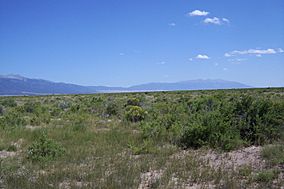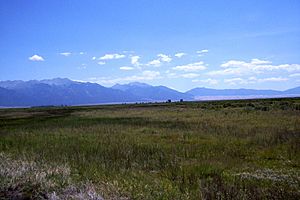Baca National Wildlife Refuge facts for kids
Quick facts for kids Baca National Wildlife Refuge |
|
|---|---|
|
IUCN Category IV (Habitat/Species Management Area)
|
|

View southeast from the northwest corner of the original Luis Maria Baca Grant #4, now included in the Baca NWR, the Great Sand Dunes and the Sangre de Cristo Range are in the background
|
|
| Location | Saguache & Alamosa counties, Colorado, United States |
| Nearest city | Alamosa |
| Area | 78,697 acres (318.48 km2) |
| Established | 2003 |
| Governing body | U.S. Fish and Wildlife Service |
| Website | Baca National Wildlife Refuge |
The Baca National Wildlife Refuge is a special place in southern Colorado, covering about 78,697 acres. It's a United States National Wildlife Refuge, which means it's a protected area for wildlife. You can find it within the beautiful Sangre de Cristo National Heritage Area.
Contents
Animals of Baca Refuge
This refuge is home to many different animals, especially birds! In the areas near rivers and streams, you might spot birds like the kestrel, great horned owl, northern flicker, robin, yellow warbler, and Bullock's oriole.
Many kinds of waterfowl also live here. Look for mallards, pintails, teal, Canada geese, avocets, killdeer, white-faced ibis, egrets, and herons.
Where is Baca Refuge?
The Baca National Wildlife Refuge is located in the San Luis Valley of southern Colorado. It's near a town called Crestone, Colorado. The refuge stretches across parts of Saguache and Alamosa counties. It's about 30 miles (48 km) northeast of Alamosa and sits on the west side of the Sangre de Cristo Range.
The United States Congress decided to create this refuge in 2000. It was part of a bigger plan that also created the nearby Great Sand Dunes National Park. The refuge officially started in 2003, and the United States Fish and Wildlife Service manages it. It works together with the Alamosa and Monte Vista National Wildlife Refuges as part of a larger protected area system.
What is Baca Refuge Like?
The Baca National Wildlife Refuge has wide open rangelands and some wetlands, which are marshy areas near rivers. The original buildings from the ranch that used to be here are still on the refuge. To help manage the land, some grazing by animals and hay production still happen in a small way. The refuge also has thousands of acres of hay meadows that are watered by irrigation.
Several streams flow into the refuge from the nearby Sangre de Cristo Mountains. One of these, Crestone Creek, is fed by springs. It's home to four types of native fish, including the Rio Grande sucker and the fathead minnow.
History of the Land
Creating the refuge and the national park involved a big land deal. The federal government worked with groups like the Nature Conservancy and the State of Colorado to make it happen. About 3,300 acres of the land were previously managed by the U.S. Bureau of Reclamation and were given to the Fish and Wildlife Service.
A large part of the land for the refuge and park, about 97,036 acres, was once part of the historic Baca Ranch. the Nature Conservancy bought this land before it was given to the federal government. The refuge is now part of a network of wetlands in the San Luis Valley. This network includes lands owned by other groups, like the Colorado Board of Land Commissioners and the National Park Service.
Oil and Gas Exploration
Sometimes, the land of the Baca National Wildlife Refuge might have natural resources deep underground. The rights to these minerals, like natural gas, are owned by a company called Lexam Explorations (U.S.A.) Inc. (Lexam). There's a small chance that they could find enough natural gas to be useful. In fact, there's an old artesian well on the land that produced enough gas to heat one home!
Protecting the Refuge
Because of the possibility of finding gas, the U.S. Fish and Wildlife Service works to make sure the refuge is protected. They require special rules and measures to be followed during any oil and gas exploration. This is to make sure the land, water, and wildlife are not harmed.
The goal is to protect the surface of the refuge, including all its natural resources and its beauty. Any exploration would be temporary, lasting less than 180 days. The Fish and Wildlife Service wants to ensure that these activities do not cause significant damage to the refuge.
Gallery
-
Capped artesian well






